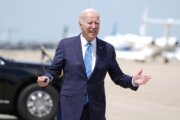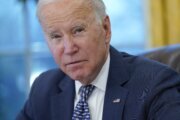INDIANAPOLIS (AP) — Southern California coach Lincoln Riley strolled across the Lucas Oil Stadium stage for the first time Wednesday, greeted by a familiar tune — “Fight On.”
He was nowhere near the only newcomer to this week’s Big Ten Media Days.
Riley’s remarks were preceded by those of first-year UCLA coach DeShaun Foster and new Michigan State coach Jonathan Smith, who left his alma mater, Oregon State, in November.
But for all three, this was they’re official welcoming party as four former Pac-12 schools and Smith made the move to the Big Ten.
“It’s an honor to be here today, an honor to be welcomed into the Big Ten,” Riley said in his opening remarks. “It’s a historic day and year. I know this has been an idea that’s been talked about for a long time, been discussed, and now I think we’re all glad that it’s finally here.”
Sure, it’s been two years since the announcement that USC and UCLA would join the 14-team league. They, like Oregon and Washington, will become official Big Ten schools next week. The Ducks and Huskies are scheduled to take questions Thursday in Indy as the grand preseason kickoff wraps up.
Now comes the hard part: navigating the twists and turns of a league that spans the country, with games running anytime from noon to midnight eastern time.
Conference officials already have started adapting.
After scrapping the previous division format to determine the title game matchup, they’ve decided to let the league’s top two teams play for the conference crown Dec. 7 at Indianapolis.
And even as players and coaches talk eagerly about visiting some of college football’s oldest and grandest venues — ranging from the Rose Bowl to The Horeshoe to The Big House — the logistics of reaching those sites comes with potential obstacles.
Some will traverse time zones, possibly multiple times each season — something that will become more prevalent in non-football sports. Getting there from some locales, even with charters, could be tricky, too. Just ask Penn State coach James Franklin.
“Those challenges are magnified for Penn State, being one of the most Northeast schools without an international airport,” he said. “So we spent a ton of time talking to NFL organizations, as well as college programs that have done East Coast to West Coast travel during the season, to find what are the best practices for that.”
There will be changes on the field, too.
Offensive lineman Jonah Monheim said Trojans coaches asked their players to add more body mass this season because the fleeter, high-scoring Pac-12 teams would be squaring off with more physical teams in the Big Ten. UCLA defensive lineman Jay Toia said he got a similar message on his campus, though he didn’t consider it anything out of the ordinary.
“There was definitely a concerted effort to add just pure mass and it makes me feel safer back there,” USC quarterback Miller Moss said. “I’m excited to see those guys just keep getting bigger.”
And those style variances won’t just affect the new schools. On Tuesday, players from the former West Division schools also were asked to assess how their more prevalent smashmouth ground game style would fare against the spread offenses that dominated the East.
If the championship game results are any indication, not well. The East champion won every crown after ditching the Leaders and Legends Divisions in 2013.
Another wrinkle will be game-planning for new opponents.
Most teams head into each season strategizing for who and what they’ll face in conference play. Now, the four new teams are starting over as the rest of the Big Ten scrambles to find game tape of its new foes.
“Studying the defenses hasn’t been difficult, but it terms of personnel grouping, there’s a lot of teams that use two and three tight ends at any given moment,” Moss said. “So some of the formation tape and stuff like that doesn’t necessarily line up with what we’re doing.”
And then, of course, there’s the question about whether West Coast teams will be at a disadvantage in the Midwest’s late-season wintry, windy weather conditions.
Riley contends it won’t matter to his team. Longtime Iowa coach Kirk Ferentz disagrees.
“I think the bigger issue is going to be travel for them,” Ferentz said. “But if we were playing a West Coast team, I’d rather play them in November when its rotten and miserable.”
But this appears to be a marriage built to last with everybody singing the same, old tune regardless of what the critics contend.
“The thing you learn pretty quickly is everything in programs like this is going to be sensationalized one way or another,” Riley said. “It’s always going to be talked about, and you either want to be in programs like that or you don’t. I take it as a compliment that we’re on a lot of people’s minds.”
___
Get poll alerts and updates on the AP Top 25 throughout the season. Sign up here. AP college football: https://apnews.com/hub/ap-top-25-college-football-poll and https://apnews.com/hub/college-football
Copyright © 2024 The Associated Press. All rights reserved. This material may not be published, broadcast, written or redistributed.





